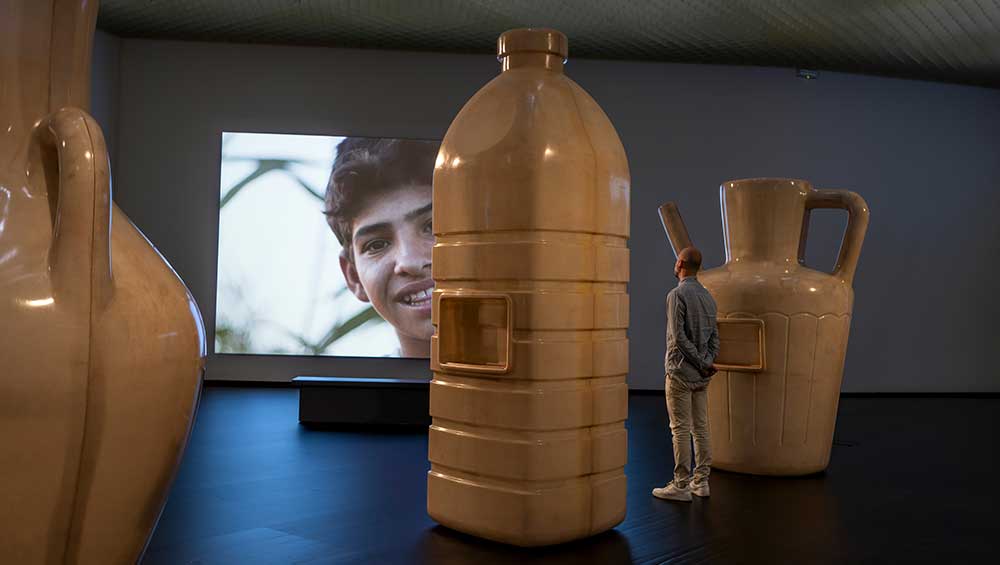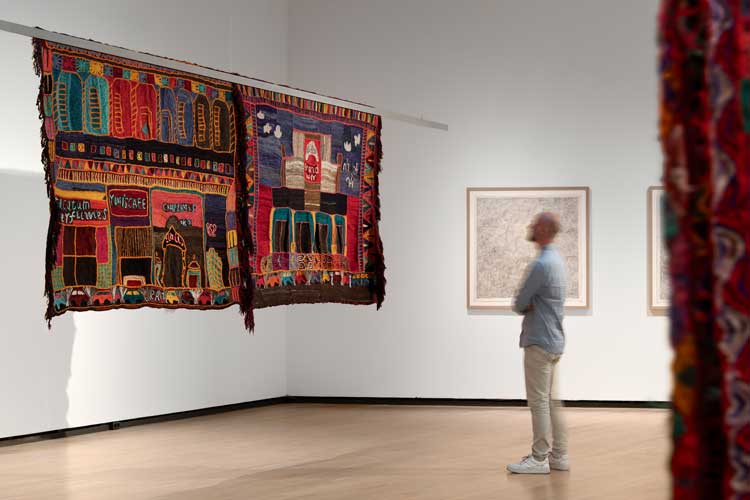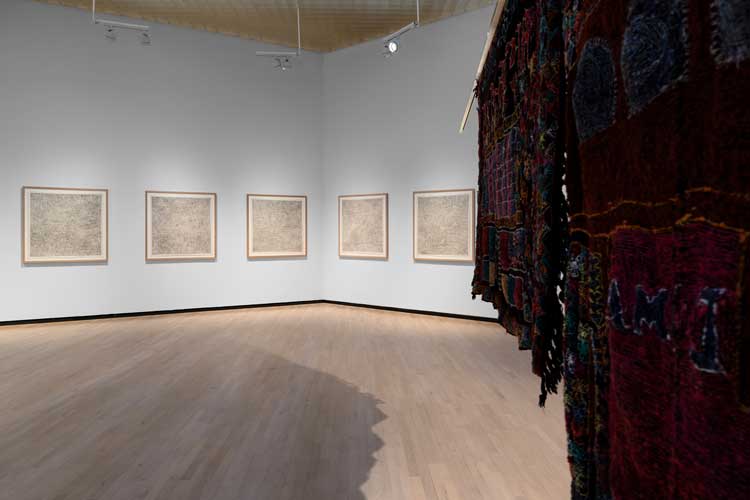
Alia Farid, In Lieu of What Is, 2022. Installation view, Henie Onstad Kunstenter, Høvikodden, Norway. Photo: Christian Tunge.
Henie Onstad Kunstenter, Høvikodden, Norway
13 September 2024 – 5 January 2025
by JOE LLOYD
Bneid Al Gar is a suburb of Kuwait City. It is also the name of the Kuwaiti-Puerto Rican artist Alia Farid’s solo exhibition at Henie Onstad Konstall, a spectacular modernist art centre on the Oslo fjord. The show is part of Farid’s reward for winning the Lise Wilhelmsen Art Award, granted biannually to an artist “making work that is important and relevant to our time”. Farid translates Bneid Al Gar as “land of tar”, referencing her upbringing in a nation physically and economically marked by oil extraction.
None of the works on display takes oil as their overt subject, but nonetheless the substance slicks through the exhibition. The floor has been clothed in black plastic vinyl, an industrial byproduct. In Lieu of What Is (2022), a series of five large sculptures arranged in a row, are made from fibreglass and polyester resin, the latter of which is created by a reaction between air, water and petroleum.
.jpg)
Alia Farid, Palm Orchard, 2022. Installation view, Henie Onstad Kunstenter, Høvikodden, Norway. Photo: Julie Hrnčířová (Studio Abrakadabra).
Outside the Henie Onstad, Farid has installed Palm Orchard (2022), a trio of sculptures that resemble PoMo abstractions of palm trees. At night they sparkle with a hypnotic light show. We are told that these fake plastic trees are common in the Gulf. Perhaps they resemble a memory of ancient date-palm groves, destroyed in the Iran-Iraq war to stop their seizure by enemy combatants. Oil played an outside role in this war, too, with each side attempting to cripple the other by striking tankers and refineries.
Chibayish (2022-23), a film in two chapters, was shot in the Iraqi marshlands near Basra, at the meeting of the Tigris and the Euphrates. This area, historically the region’s largest source of water, has substantial oil reserves. The state pockets the revenue from this resource, while local residents face environmental decline, toxic pollution from American uranium bombs, less-than-basic health services and the drying up of the marshes they rely on for sustenance. Farid’s film follows three teenage boys as they play, dance and ride water buffaloes through these threatened wetlands. Sometimes, in the distance, we can see the grey towers of refineries. One shot shows a pipe spurting something filthy into the water.
Chibayish comes in the one-camera cinéma vérité mode typical of many contemporary art films. There are slow movements across the marshes. At one point a poem is read out. Cynically, one might say that the sparseness of this aesthetic can stand in for profundity; the longueurs give the viewer time to fill any gap with their own thoughts. But Chibayish is nevertheless a compelling example of this genre. And it has some twists: a computer-augmented section shows plastic water bottles floating around a ziggurat: a symbol of the birth of civilisation strewn with the trash of its contemporary descendants.
.jpg)
Alia Farid, In Lieu of What Is, 2022. Installation view, Henie Onstad Kunstenter, Høvikodden, Norway. Photo: Christian Tunge.
In Lieu of What Is invokes another historical progression. It was once a Kuwaiti custom to leave out a water vessel for passing travellers. Farid has reimagined this practice for the petrochemical age. Three of her sculptures imitate the form of vernacular vessels; one a petrol can and one a disposable bottle. Each has two apertures moulded to resemble a commercial water fountain.
Here, Farid pushes a tradition to an absurd potential end point. The act of giving has become a forgotten shibboleth, but the objects associated with it remain, transformed into functionless alabaster-toned idols. The spectre of climate change lurks: are these from a future where water has become something too precious to give away? That they are made of an oil byproduct, from an industry that is spoiling the region’s water, might suggest our skewed qualities.
There are a lot of suggestions in Farid’s sculptural works. Their physical immediacy as objects is measured with a certain inscrutability. Artists, says Farid, in an interview for the exhibition catalogue with curator Maria Inés Rodriguez, “resist by transgressing internal and external boundaries and by asking questions all the time”. At times, I would like more answers. What do these sculptures assert?
.jpg)
Alia Farid, Elsewhere, 2023. Installation view, Henie Onstad Kunstenter, Høvikodden, Norway. Photo: Christian Tunge.
The same critique could be levelled at Elsewhere (2023), which originally appeared last year at the Chisenhale Gallery in London. Yet these works have a presence and layering of ideas that make up for the ambiguity of their message. They are surpassingly pretty: 15 bright, bold tapestries, hung from rails and presented in two rows. In London, the rows were parallel; here the two lines draw closer and closer together, creating a sense of a claustrophobic alley.
The majority of the pieces depict the buildings of the Palestinian diaspora in Puerto Rico. There are cafes, mosques, pharmacies and perfumeries, places of ritual and community. These are surrounded by words in Arabic, various decorative motifs that evoke both Arabic art and the latticed balusters and ironwork that characterise Puerto Rican architecture, and naive depictions of cars, camels, birds and flowers.

Alia Farid, Elsewhere, 2023. Installation view, Henie Onstad Kunstenter, Høvikodden, Norway. Photo: Christian Tunge.
One striking anomaly depicts the menu at an Arabic restaurant in San Juan, which promises such cross-continental dishes aspavo asado, mofongo relleno de polloand, somewhat more surprisingly, pasta carbonara. These phrases have themselves been dislocated, turned from words into images – just as they might to a migrant unfamiliar with the alphabet of their new home.
Elsewhere is a paean to the way cultures can survive, and thrive, after migration from war and colonial violence. As with Farid’s sculptural work in the exhibition, it takes an item from Arab material culture and morphs it into a comment on historical processes. The rugs were created in collaboration with Iraqi weavers, adding another element of cultural exchange. Farid led the studio in drawing, before the weavers’ chain wove these vivacious patterns atop recycled textiles. She chooses to use the garish, loud colours of synthetic dye to reference our poisonous behaviour on Earth. Iraq, once famous for its natural colourings, now has to rely on artificial substitutes.

Alia Farid, Izar 1–6, 2024. Installation view, Henie Onstad Kunstenter, Høvikodden, Norway. Photo: Christian Tunge.
Elsewhere is complemented by Izar (2024), a series of graphite drawings on paper. Named for a sarong-esque fabric wrap, they were created through frottage over traditional Iraqi tapestries, on textured palm paper that makes them protrude like a relief. These are Elsewhere’s haunted echoes. The effervescent cross-stitching is replaced by a greyscale field. In some drawings, the patterns and motifs are clear; in others, they are blurred out, as if dissipating through memory loss. Though wordless, they are perhaps Farid’s most eloquent works to date.